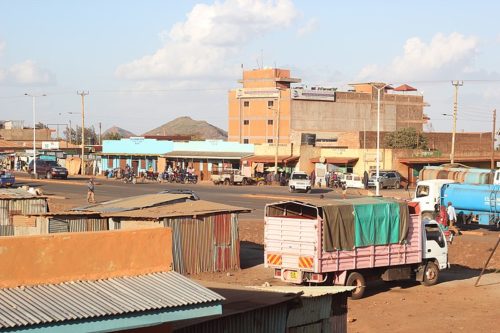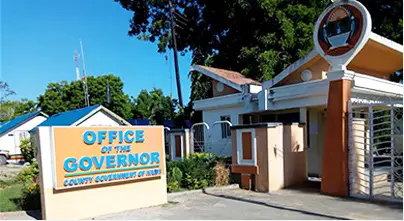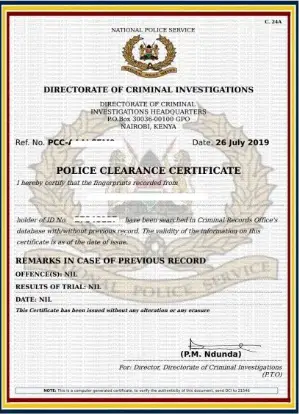Marsabit Town is a small, remote town located in the northern part of Kenya. The town is situated in the former Eastern Province, and is almost completely surrounded by the Marsabit National Park.
The town is located about approximately 530 kilometers North East of Nairobi, at an elevation of between 1300 and 1400 meters.
The town is named after a farmer who once visited the location where the town currently is. The name Marsabit is believed to have come from the Amharic word “Marsa Bet,” which translates to “Marsa’s home.”
The town is a melting pot of different cultures, with the Borana, Rendille, Samburu, and Turkana tribes all living in the area.
Despite its small size, Marsabit Town has a rich history and culture. The town is home to several historic sites, including the Marsabit Mountain, an extinct volcano that is protected in a national park and covered with forests.
The town is also known for its vibrant market, where locals sell everything from traditional crafts to fresh produce.
Visitors can experience the local culture by visiting the market, attending a traditional dance performance, or exploring the nearby national park.
Geographical Location
Marsabit Town is located in the northern part of Kenya, specifically in Marsabit County.
The town is situated in the former Eastern Province and is almost entirely surrounded by the Marsabit National Park.
The town’s geographical coordinates are 2.33468° N latitude and 37.99086° E longitude 1.
Climate
Marsabit Town has a semi-arid climate, which is characterized by hot and dry weather. The town experiences two rainy seasons, which occur between March and May and between October and December.
The average annual rainfall is approximately 500 mm. The average temperature in Marsabit Town is 25°C, with the hottest months being January to March and the coolest months being July to September.
Terrain
Marsabit Town is situated at an elevation of between 1300 and 1400 meters above sea level.
The town is located on the slopes of the Marsabit Mountain, which is a 6300 km² basaltic shield volcano in Kenya.
The mountain is located approximately 170 km east of the center of the East African Rift. The terrain in Marsabit Town is mostly flat, with some rocky hills and outcrops in the surrounding areas.
Historical Background
Marsabit Town, located in the northern region of Kenya, has a rich history that dates back to pre-colonial times.
The town is believed to have been named after a farmer who once visited the location where the town currently is.
The name “Marsabit” is said to have originated from the Amharic word “Marsa Bet,” which translates to “Marsa’s home” in English.
The town has been inhabited by a number of indigenous communities, including the Borana, Rendille, Samburu, and Gabra.
These communities have lived in the area for centuries, and have developed their own unique cultures and traditions.
In the late 19th century, the British established a military outpost in Marsabit, which they used to control the region.
The outpost was later converted into a trading center, and the town began to grow rapidly.
In the early 20th century, the construction of a railway line from Mombasa to Nairobi further boosted the town’s growth, as it became an important stopover for travelers and traders.
During the colonial period, Marsabit was a hub for ivory and slave trade. After Kenya gained independence in 1963, Marsabit became the capital of the Marsabit District, which was later converted into Marsabit County.
Today, Marsabit Town is a vibrant center of commerce and culture, with a population of over 20,000 people.
The town is home to a number of important institutions, including the Marsabit National Park, which is a major tourist attraction.
Despite its rich history, the town faces a number of challenges, including poverty, lack of infrastructure, and environmental degradation.
However, the people of Marsabit remain resilient and continue to work towards a brighter future for their town and their community.
Population and Demographics
Marsabit Town is located in the Marsabit County of Kenya. According to the Kenya National Bureau of Statistics, the town had a population of about 14,900 as of 2019.
The population of Marsabit Town is predominantly Cushitic-speaking Rendille, Borana, Gabra, Sakuye Oromo, Dasenach, and Burji ethnic groups, who are mostly traders and herders with settlements in urban centers.
Marsabit town is within Marsabit county which has the following demographics:
- The population of Marsabit County was 459,785 as of the 2019 Kenya Population and Housing Census.
- The county has a relatively low population density of 4.8 persons per square kilometer, which is significantly lower than the national average of 83 persons per square kilometer.
- Marsabit County has a rural-urban population split of 76.7% and 23.3%, respectively.
- The age distribution of the population in Marsabit County is as follows: 46.9% are aged 0-14 years, 50% are aged 15-64 years, and 3.1% are aged 65 years and above.
- The gender split in the county is almost equal, with females comprising 50.1% of the population and males comprising 49.9%.
- The literacy rate in Marsabit County is 38.9%, which is significantly lower than the national average of 78.3%.
- The county also has a higher proportion of the population living below the poverty line compared to the national average. The poverty rate in Marsabit County was 77.1% as of 2015, which is almost double the national average of 36.1%.
Economy
Marsabit Town is a developing urban center with a growing economy. The town’s economy is largely driven by agriculture and business and commerce.
Agriculture
Agriculture is a significant contributor to the economy of Marsabit Town. The town is located in a semi-arid region, and livestock farming, with cattle, goats, and sheep being the most common animals reared by the locals.
The livestock industry is a significant source of income for the town’s residents, with livestock products such as milk, meat, and hides being sold locally and to other parts of the country.
Business and Commerce
Marsabit Town has a thriving business and commerce sector. The town is a hub for trade and commerce in the region, with a large number of shops, markets, and trading centers.
The town has several small supermarkets, banks, and other financial institutions, making it easier for residents to access financial services.
The town also has a vibrant informal sector, with small-scale businesses such as kiosks, food stalls, and small shops operating in various parts of the town.
The town is also home to several hotels and restaurants, which serve both locals and tourists.
The tourism industry is growing in the town, with several attractions such as Mount Marsabit National Park, which is home to a wide range of wildlife, including elephants, buffaloes, and giraffes.
The town also hosts several cultural festivals throughout the year, which attract visitors from all over the country.
Infrastructure
Marsabit Town has made significant progress in improving its infrastructure in recent years. The town’s infrastructure has attracted investments, which have helped the town to grow and thrive.
Transport
Transportation infrastructure in Marsabit Town has improved significantly in recent years. The town connects to Nairobi through the national highway A2.
The upgrading of Marsabit town into a municipality has led to the upgrading of roads to bitumen standards, including the Moyale and Marsabit Town roads.
The Merille-Marsabit-Moyale roads have also been completed, and 474.6 km of roads have been graded and graveled.
New roads have also been opened, making it easier for people to travel in and out of the town.
Health Facilities
Marsabit Town has several health facilities that provide quality healthcare services to its residents.
The Marsabit County Referral Hospital is the main hospital in the town, providing a wide range of health services.
The hospital has several departments, including a maternity ward, a surgical ward, and a pediatric ward.
Other health facilities in the town include the Catholic Mission Hospital and the Seventh Day Adventist Hospital.
Education Institutions
Marsabit Town has several educational institutions that provide quality education to its residents.
The town has several primary and secondary schools, including Marsabit Boys High School, Marsabit Girls High School, and Marsabit Primary School.
The town also has several tertiary institutions, including Marsabit Technical Training Institute and other private colleges.
Culture and Traditions
Marsabit Town is home to various tribes, each with its unique culture and traditions. The town is a melting pot of different cultures, and this is evident in the various festivals and events that take place throughout the year.
One of the most significant cultural events is the Loiyangalani Festival, which takes place in July every year.
The festival brings together various tribes, including the Samburu, Rendille, Borana, and Turkana, to celebrate their culture through music, dance, and traditional dress.
Visitors can also sample local delicacies and participate in various activities, such as camel racing and traditional wrestling.
Another cultural event is the Marsabit Cultural Festival, which takes place in December.
The festival celebrates the cultural diversity of the town and showcases the traditional dances, music, and dress of the various tribes.
Visitors can also participate in activities such as camel rides, traditional games, and food tasting.
The Gabra people, one of the tribes in Marsabit, have a unique tradition of using singing and dancing to resolve conflicts.
Known as “Gabra Singing Wells,” the tradition involves singing and dancing around a well to resolve disputes over water usage.
The tradition has been passed down from generation to generation and is still practiced today.
The town is also home to various handicrafts, such as beadwork, woodcarving, and basket weaving. Visitors can purchase these items as souvenirs and support the local economy.
Tourism and Attractions
Marsabit Town is a hidden gem in Kenya, with a unique blend of natural beauty and cultural heritage.
The town offers tourists a chance to explore its rich history, diverse culture, and stunning landscapes. Here are some of the top attractions and activities to enjoy in Marsabit Town:
Marsabit National Park
Marsabit National Park is a must-visit destination for nature lovers.
The park covers an area of 1,554 square kilometers and is home to a wide variety of wildlife, including elephants, buffalos, leopards, and hyenas.
Visitors can enjoy game drives, bird watching, and hiking in the park.
Lake Paradise
Lake Paradise is a beautiful crater lake located in Marsabit County. The lake is surrounded by lush green vegetation and is home to a variety of bird species.
Visitors can enjoy boat rides, fishing, and picnics by the lake.
Loiyangalani Rock Art
Loiyangalani Rock Art is a collection of ancient rock art sites in Marsabit County. The rock art sites include Surima, Marti, and Afgaba.
The rock arts consist of ancient images and symbols that illustrate different eras when the region supported different cultures and diverse human population.
Chalbi Desert
Chalbi Desert is a unique landscape that is characterized by sand dunes and salt flats. The desert is located in the northern part of Marsabit County and covers an area of 100,000 hectares.
Visitors can enjoy camel rides, camping, and hiking in the desert.
Marsabit Town Market
Marsabit Town Market is a bustling market that offers visitors a chance to experience the local culture and buy authentic Kenyan souvenirs.
The market is located in the heart of Marsabit Town and is open every day. Visitors can buy handmade crafts, textiles, and local produce.
Marsabit Town is a destination that offers something for everyone. Whether you are a nature lover, a history buff, or a culture enthusiast, you will find something to enjoy in this beautiful town.
Challenges and Opportunities
Marsabit Town, located in northern Kenya, is faced with a number of challenges and opportunities. Here are some of the most pressing ones:
Challenges
- Conflict: Marsabit County has been plagued by conflict, with competition for land and water resources being the main driver. This has led to violence that is increasingly politically instigated.
- Poverty: The poverty rate in Marsabit County is high, with over 70% of the population living below the poverty line.
- Lack of infrastructure: The town has limited infrastructure, including poor road networks, inadequate water supply, and limited access to electricity.
Opportunities
- Tourism: Marsabit has a unique ecosystem, with heavily forested hills in contrast to the surrounding desert. This makes the town a potential tourist destination, especially for nature lovers and adventure seekers.
- Renewable energy: Marsabit has great potential for renewable energy, including solar and wind power, due to its location in a region with high solar radiation and strong winds [2].
- Agriculture: Despite the challenges of the arid climate, there are opportunities for agriculture in Marsabit, especially in the areas of horticulture, beekeeping, and livestock farming.
While Marsabit Town faces significant challenges, there are also opportunities for growth and development.
Addressing the challenges and taking advantage of the opportunities will require concerted efforts from the government, private sector, and local communities.
Future Prospects
Marsabit town is poised for significant growth and development in the coming years. The Kenyan government has identified the town as a strategic location for various development projects, including the establishment of a spaceport.
In November 2021, Marsabit County was selected as the most suitable site in Kenya to set up a spaceport, beating out other counties in the country.
The proposed spaceport is expected to attract significant investment and create new employment opportunities for the local population.
The Kenyan government is also investing in the development of infrastructure in Marsabit town.
The construction of new roads, including the completion of Marsabit-Moyale highway, is expected to improve connectivity and boost economic activity in the region.
The government is also investing in the expansion of the Marsabit airport, which is expected to increase air traffic to the town and facilitate the movement of goods and people.
The development of the town’s tourism industry is another area of focus for the government.
Marsabit National Park, which is located near the town, is a popular tourist destination known for its diverse wildlife and unique landscapes.
The government is investing in the development of new tourism infrastructure, including the construction of new lodges and campsites, to attract more visitors to the region.
Frequently Asked Questions
What is the history of Marsabit Town, Kenya?
Marsabit Town is located in Marsabit County, which is in the northern part of Kenya. The town sits on an extinct volcano, Mount Marsabit, which is almost a kilometer high.
The town has a long and rich history that dates back to the 13th century. It was an important trading center for the Borana people, who traded with other communities in the region.
In the 19th century, the town was a center for slave trade. The town has since grown to become an important center for trade, education, and tourism.
What is Marsabit Town known for?
Marsabit Town is known for its unique location, sitting on an extinct volcano that provides a stunning view of the surrounding area.
The town is also known for its diverse culture, with a mix of different communities living in the area.
The town is also a hub for trade, with many markets and shops selling goods from all over the region.
What are the largest communities in Marsabit Town, Kenya?
The largest communities in Marsabit Town are the Borana, the Gabra, the Rendille, and the Samburu. Each community has its own unique culture and traditions.
How far is Marsabit Town from Nairobi, Kenya?
Marsabit Town is approximately 530 kilometers (340 miles) from Nairobi, Kenya. The journey takes approximately 10 hours by road.




